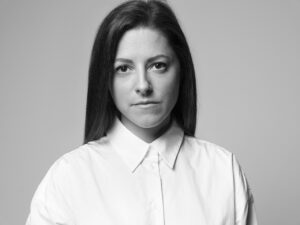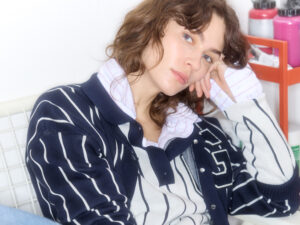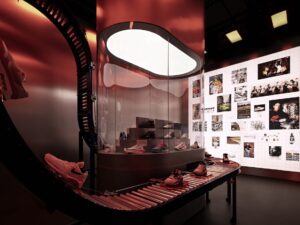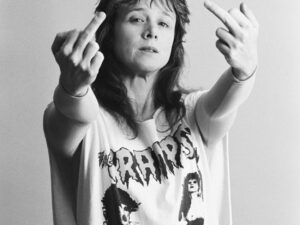A new line of fine jewelry – designed in Berlin – ethically handcrafted in Armenia – & honestly priced.
Interview: OUVERTURE by Kris Ter-Ghazaryan
Yellow, rose, or white gold – what is your very favorite?
I wear yellow gold and occasionally white gold.
Three things everyone should know about fine jewelry.
1. Fine jewelry is made of solid gold: it won’t fade.
2. Gold is a soft metal: your gold jewelry will scratch.
3. You will need to treat your fine jewelry with care. Metal does not
mean “unbreakable”.
The first fine jewelry piece to invest in, to start a personal small collection?
Diamond studs, they are the equivalent of the white t-shirt in fine jewelry.
What was your very first fine jewelry piece and when did you get it?
A pair of golden earrings with pearl drops. My mom gave them to me when I got my ears pierced. I never wore them though; I thought they were too big (and a little conservative).
The most beautiful jewelry piece you ever saw?
Fernando Jorge’s ‘Disco’ line (the earrings, rings, and the choker) from his ‘Brilliant’ collection.
The country with the most sophisticated fine jewelry taste?
France. With most sophisticated taste in pretty much everything.
The most iconic high jewelry movie piece?
Audrey Hepburn’s diamond and pearl necklace from “Breakfast at Tiffany’s”.
Fine jewelry is still mainly about status, would you agree?
Nowadays, fine jewelry is about self-expression and style more than status, I think.
For the longest time, fine jewelry was considered as a gift-only item. But that trend has shifted as the modern woman no longer waits for a special occasion or a man to purchase fine jewelry. She knows what jewelry she wants and she purchases it herself to compliment her personal style.
Tell us more about Armenia and its old tradition of jewelry making. What kind of experience did you do in Armenia? What is so special in the way they make jewelry and how would you describe the style?
The jewelry making in Armenia dates back to ancient times, and it has been treated as a form of art for thousands of years. Armenian ancient jewelry pieces preserved in museums are really sophisticated masterpieces with rich motifs that tell the story of one of the oldest nations in the world. Jewelry-making is such a big part of our history and culture; we take great pride in preserving this tradition. The contemporary Armenian jewelry uses many of the themes and motifs from ancient times, and it is rich and expressive.
You worked in investment management before. What were your experiences working with Berlin-based startups? How did you experience the berlin startup scene? Any lessons made during that time?
Coming from a highly professional environment, I had issues adjusting to the Berlin startup environment, where the level of professionalism and expertise was lagging. Nonetheless, I made a decision to fully embrace my startup experience and learn as much as I could. If I were, to sum up: I ended up learning a lot about how one should not run companies and people – which was nonetheless helpful and essential in shaping my own approach to how I should build, manage and scale my own startup.
What is your major advice for a startup company in any industry? And for a fashion-related startup?
Be realistic – at this age, there is perhaps at least one other company doing something similar (or will start doing something similar): so be laser-focused on actually creating value for your customer, otherwise you are irrelevant. Evaluate your performance from day one. Instead of coming up with a dozen excuses why your performance isn’t where it should be, find out why it isn’t. Don’t compare yourself to others, and don’t get comfortable when things are going well; you’ll sabotage your success and become truly boring. And find that reason that will get you going when the going gets tough early on. Because it will.
What is your advice to all women who want to start their own business?
Take the first step regardless of your fears and doubts. Be flexible. Focus on “becoming” rather than “doing”. When you become the person you want to become, you will automatically end up doing the things you want to do. Be prepared to make tough choices, and know that not everyone will be comfortable with them. Be persistent. Have strong faith and a stronger game plan. Pay attention and don’t stop learning.
What made you found your own brand?
The idea to start a jewelry brand came to me when I realized that I cannot find a simple dainty diamond line ring that is also attainable. That fact, coupled with my passion for fashion and design, my fascination with the direct-to-consumer business model that originated in the States, and my strong desire to build a company that I would actually want to work for in Berlin are the factors that got me started.
How would you describe your brand in three words?
Contemporary. Timeless. Elegance.
What does it mean to you to work creatively now, especially having a different background?
My previous background – so focused on theories, facts, and numbers – left little room for developing or rather enabling creativity (of course you are also creative when you consult your clients on business issues or make investment decisions but that’s not the type of creativity, I am referring to here). Working creatively means reinventing myself.
What does creative freedom mean to you and where are the limits?
Creative freedom means completely losing my old definition of self, disconnecting from the outside world, and being in tune with my inner world. Practicability limits my creative freedom when designing jewelry.
Where do you buy your gold?
We buy our gold in Armenia.
What is your favorite jewelry piece you designed so far?
The Diamond Double Ring 0.10 from Collection 03.
What is the biggest challenge when designing jewelry pieces/a whole collection?
Staying practical.
How would your craziest phantasy jewelry piece look like (no matter if realistic or not)?
My fantasy is not really crazy. I’d like to make a bangle version of a few of our rings. Our head jeweler was not convinced last time I checked, haha. I will have to fine-tune this idea a bit more.
What are your aims still for 2020?
To work on my German!
Interview: Sina Braetz
Images Courtesy of Edda Petursdottir and Lotte Thor



